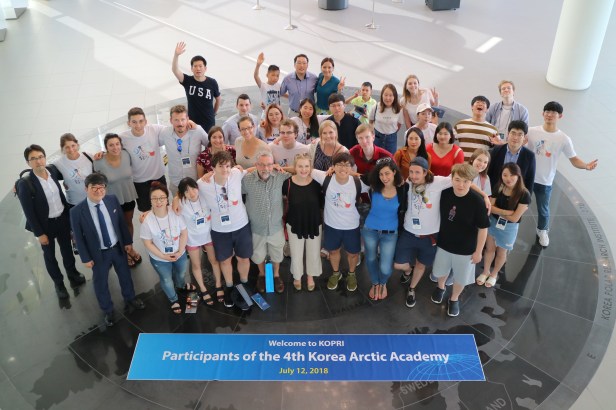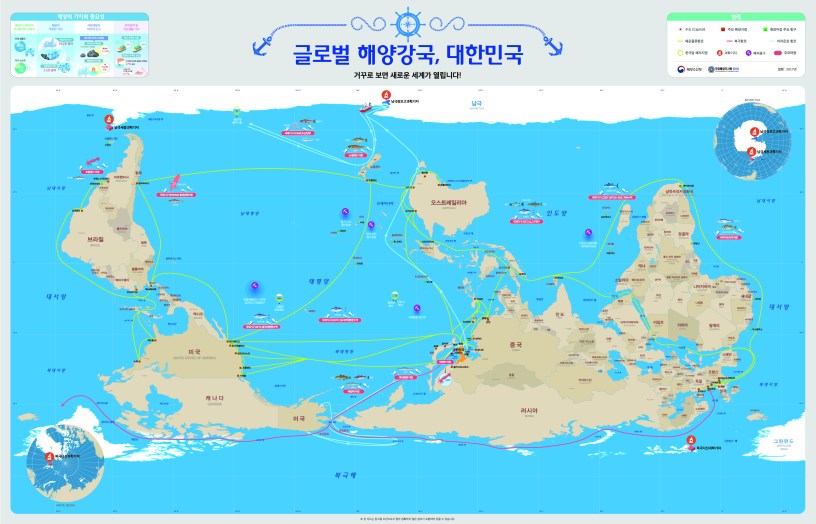Overview of the Korea Arctic Academy
This July (4 – 14th) I travelled to Busan, South Korea for the 4th Korea Arctic Academy (KAA), an early-career workshop organized by the UArctic network together with the Korea Maritime Institute (KMI) and hosted by the Ministry of Oceans and Fisheries. With 36 students/early career scientists and about 15 invited speakers from S. Korea and the Arctic Five (Canada, Kingdom of Denmark, Norway, Russia, U.S.), the workshop addressed a wide array of topics related to the Arctic.
The topics covered in KAA that piqued my interest relate to maritime and marine related issues. Representatives of the local embassies from Denmark, Norway, Finland and the U.S. took the time to talk about their national Arctic policies as well as their interests in Korea’s commercial and research activities.

Korea in the Arctic
Korea’s interest in the Arctic is multidimensional. Although a non-Arctic state, S. Korea has held observer status to the Arctic Council since 2013. In that same year S. Korea developed its first Arctic Policy Master Plan and conducted its first commercial test voyage through the Northern Sea Route in the Arctic. Two years later, in 2015, the Korea Arctic Academy program was launched for the first time. As Marc Lanteigne, an Arctic political sciences scholar, points out, such educational activities along with investments in science and R&D, rank highly in importance for S. Korea. Other examples of initiatives that demonstrate Korea’s communication strategies of its research interests and expertise in the Arctic include the establishment of the Korea Polar Portal Service, the Korea-Japan-China Arctic high level dialogue, the North Pacific Arctic Conference, the Korea Arctic Experts Network, and its increasing participation in projects such as the Svalbard Integrated Arctic Earth Observing System.
Shipping, Shipbuilding, and Trade
Almost 99.7% (2014) of S. Korea’s total external trade takes place via shipping, and the shipping industry accounts for more than 2.7% (2012) of the country’s GDP[1]. The historical military and political tensions with North Korea render S. Korea essentially an island and therefore highly dependent on shipping. S. Korea’s stakes for the development and use of a successful shipping lane in the Arctic are therefore high. In 2015, the first Korean cargo vessel conducted a commercial operation in the Arctic (sailing from the United Arab Emirates to the Yamal Peninsula, Russia). In late 2017, during the second annual Arctic Partnership Week in Busan, the Korea Shipowners’ Association was officially admitted to the Arctic Economic Council (AEC). This signals the country’s shipping and energy interests, and the Council’s appreciation of those interests as complementary to the goals of the AEC. Previous literature has identified ship-building as S. Korea’s main commercial driver for its emerging Arctic interests; there is a high expertise in ship-building requirements for ice-breakers or ice-capable freight vessels (including oil and LNG tankers). Other emerging interests in S. Korea, as highlighted by the Director of the Institute of Arctic Logistics, Sungwon Hong, include maritime transportation (heavy cargo and multimodal transportation, marketability of Korean market through the Northern Sea Route) and port services (use of its ports as transshipment hubs, ship supply services, bunkering and crew change for Arctic shipping in S. Korea).
Field trips and guided tours to DSME Shipyard and KRISO, the Korea Research Institute of Ships and Ocean engineering helped KAA participants realize the magnitude of the national ship building capacity and expertise.
Scientific Research
By 2009, S. Korea had finished the construction of the icebreaking research vessel Araon which conducted its first expedition in the Arctic Ocean the year after. According to Jong Deog Kim, a Senior Research Fellow at KMI, construction a new research ice-breaker is currently under consideration.
The Korea Polar Research Institute (KOPRI), based in Incheon (near Seoul’s main airport and about an hour from downtown Seoul), is the primary (government sponsored) research institute for the national polar program. The tour to KOPRI’s research facilities, along with Hyoung Chul Shin’s talk from the Strategy and Cooperation Division, gave the KAA participants a good understanding of the national research priorities as well as of future research plans. Facts and numbers speak for themselves: KOPRI runs a research station in Svalbard and has a number of pan-Arctic observation sites, is involved in around 20 Arctic (large and smaller) projects, sends around 200 expeditioners a year to the Arctic: an investment of around 13 mil. USD (in research grants). The Korea Arctic Research Consortium is yet another new initiative (launched in 2015), with 30 partner institutions and a secretariat at KOPRI that aims to strengthen collaboration in Korean Arctic research and bring together science, industry and policy.

Marine Resource Extraction and Conservation
S. Korea’s interests in the Arctic go beyond shipping and naval architecture though: they include, among other things, climate dynamics and ecosystem responses, geological and biological changes and the use of marine resources. Given my background in fisheries economics I have chosen to confine my attention to the later.
S. Korea has recently been actively involved in the discussions towards a Central Arctic Ocean (CAO) fisheries agreement. The idea of the agreement, which started as a non-legally binding declaration signed by the Arctic Five in 2015, was to prevent unregulated high seas fishing in the CAO. Although commercial fish stocks are not expected so far north any time soon, the intention has been to anticipate the need to protect stocks from commercial exploitation. When the agreement expanded stakeholder engagement in December 2017, S. Korea, among other major fishing powers (Iceland, Japan, China and the EU), entered into discussions for a broader 16 year agreement. The new moratorium is intended to extend and renew itself until a country objects or science-based harvest control rules are implemented.
Meanwhile S. Korea is both a large producer and a large consumer of fish and seafood products. Korean consumers spend around 8 bil. USD on fish and seafood; in 2016 their seafood imports were worth 4.5 bil. USD. The size and the variety of products one finds in Jagalchi Market, Busan’s seafood market, is a good illustration of that.
Arctic living marine resources increasingly provide new opportunities on both the supply and demand sides for fish and seafood products. Depleted fish stocks in S. Korean waters, as well as climate change and shifts in species distribution in Arctic waters, increasingly support such opportunities. Although there are plenty of examples and ample empirical evidence that support this argument, I’ll use an example from the Norwegian part of the Arctic (Barents Sea). As Forde Soldberg, the Norwegian Ambassador, pointed out in his talk, the main interests of the Norwegian private sector in S. Korea increasingly include seafood exports. The Red King Crab (P. camtschaticus) and the Snow Crab (C. opilio) from the Barents Sea are prime examples of such lucrative seafood trade businesses between the Norwegian Arctic and S. Korea. S. Korea has a long tradition in the consumption of crabs and has several domestic crabs that people have traditionally fished for, such as the Snow Crab, the Red Snow Crab (C. japonicus) and the Korean Swimming Crab (P. trituberculatus) (Yeongdeok Village is the country’s Snow Crab capital with a history on crustaceans that goes back to the Goryeo Dynasty).
Both the Red King Crab (hereafter RKC) and the Snow Crab (hereafter SC), although valuable commodities, are considered invasive in the Barents Sea.
The RKC was introduced back in the 1960s by Soviet Union scientists for marine cultivation purposes, close to the Murmansk fjord. It has only recently entered the Korean market (less than a decade ago) and is considered as one of the most premium seafood products. Until recently, the far-east Russian RKC covered most of the consumer demand in Korea,either exported frozen or delivered live (in season) via vessel from Eastern Russia; the Norwegian fisheries’ year round exporting of live crab and a reputation for high quality, combined with the Korean consumer preference for live seafood, however, has now provided Norwegian RKC fisheries with a competitive advantage at the high end of the market during some parts of the year.
Although the invasive RKC was initially considered as a pest for small-scale coastal fishers in Northern Norway, it has gradually developed into a very profitable fishery. As mentioned, the Norwegian crab industry has in recent years managed to capture S. Korea’s interest for live RKC and started transforming its infrastructure in ways that can support such export activities. This has opened new opportunities for small communities in geographical challenged locations of the Norwegian Arctic, some of which were previously on the fringe of socioeconomic collapse.
The SC is most likely an unintentional introduction further north in the Barents Sea, probably transferred via ballast water rather than through direct range expansion, and identified in the Barents for the first time in the mid 1990s. Norwegian vessels only started to fish for SC in 2012. Despite the challenges related to fishing rights in the international waters of the Loophole and the Svalbard Fishery Protection Zone, Norway has managed to capture some of the Korean demand for the product. Although S. Korea has domestic SC fisheries, the increased consumer demand as well as challenges related to overfishing and a potential northward shift of the species out of the S. Korean Exclusive Economic Zone have led to an increase in imports. Imports of SC are also new for the S. Korean market. Although Russia is currently the main SC supplier, Norwegian suppliers are currently investing in developing their SC exports (especially of live SC) through e.g. R&D on reducing mortality rates during transportation of live crab overseas to S. Korea. The declining SC quotas in Alaska and Canada, which also supply the S. Korean market, open up additional market space for the Norwegian Barents SC.
These fascinating crab stories, which I have only briefly outlined here, have motivated me and my colleagues at the University of Southern Denmark to establish a Uarctic Thematic Network on Global Ecological and Economic Connections in Arctic and Sub-Arctic Crab Fisheries. Our research questions include among others S. Korea’s interests in the Arctic crab fisheries, as well as preferences of S. Korean consumers and producers.
[1] Ha, Y. S., Chung, K. J., & Seo, J. S. (2016)
I would like to thank Korea Maritime Institute and UArctic for organizing the 4th KAA as well as my fellow participants for sharing this exciting 10-day experience. Special thanks to Do-Hoon Kim from Pukyong National University who gave me a hands-on introduction in the consumer side of the Korean crab market.
Cover image: The reverse map of the world, Ministry of Maritime Affairs and Fisheries, 2017
Remaining photo credits: Melina Kourantidou or Korea Arctic Academy 2018.









